Section 4.3. Working with an Affiliate Program
4.3. Working with an Affiliate ProgramGenerally, there are three affiliate marketing situations you may get involved with as a web content publisher:
4.3.1. Affiliate AggregatorsMajor affiliate aggregators provide the following benefits to web publishers:
You'll need at least one content-based web site to enroll with an affiliate aggregator. Once you've signed up with an affiliate aggregator, the aggregator will provide a single web site that allows you to:
Commission Junction , http://www.cj.com, and LinkShare , http://www.linkshare.com, are the two best-known affiliate aggregators.
4.3.1.1. Commission JunctionCommission Junction represents more than 1,000 merchants, ranging from Discover Card to Half.com, through dating sites, software publishers, and companies selling clothesjust about any kind of merchant you can imagine. If any legitimate product or service can be bought over the Internet, you can probably figure out a way to make a sales commission from selling it via Commission Junction. The Commission Junction home page is shown in Figure 4-4. Figure 4-4. The Commission Junction home page lets you access much of the program's functionality from a single window By choosing Account Figure 4-5. It's easy to add web sites to your Commission Junction account or edit current site information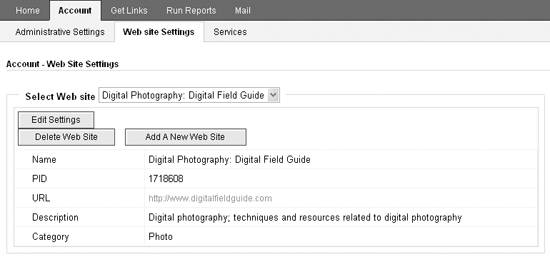
The Run Reports tab, shown in Figure 4-6, provides a very complete set of metrics covering how many times ads have been displayed on your pages (called page impressions ), how many times your ads have been clicked (called click throughs ), and the sales commissions you have earned. Figure 4-6. Commission Junction provides advanced reporting facilities you can use to learn about your page views, transactions, and sales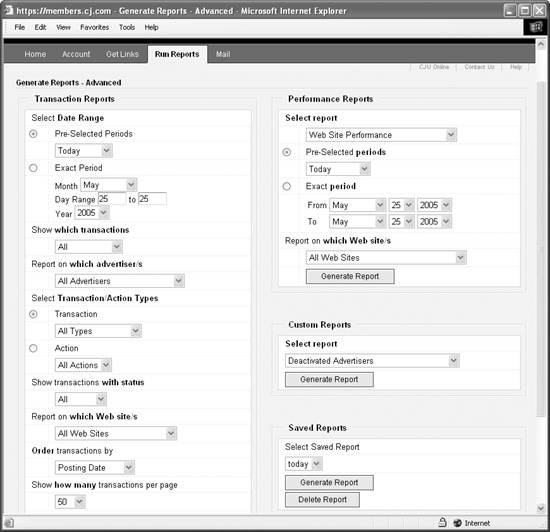 The heart of the Commission Junction interface is the Get Links tab, shown in Figure 4-7.
Using the Get Links tab, you can find merchantscalled advertisers in Commission Junction nomenclatureby category, by searching using various filters, or by listing Figure 4-7. Using the Get Links tab you can search for participating merchants by category the merchants with whom you have an existing relationship. You can also browse the entire list of Commission Junction merchants by clicking Advertiser List. Once you've found a merchant you are interested in, you can apply to join the merchant's affiliate program by checking the program application box and clicking Apply to Program, as shown in Figure 4-8. Figure 4-8. Check the box and click Apply to Program to join a merchant's affiliate program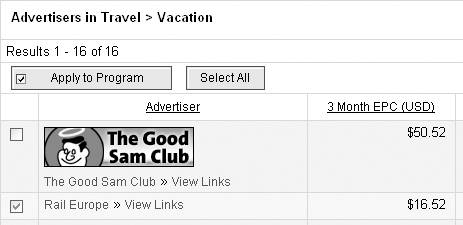
Your application to join a merchant program will either be approved automatically (if the merchant has decided to approve all would-be affiliates) or manually. During the manual approval process, which may take up to several days, your status with the merchant is set to "Pending Approval." With manual approval, you will be notified by email whether you've been accepted or rejected. Once a merchant has approved your application to join its affiliate program, you can go grab the HTML required to make links. To do this, use one of the mechanisms provided by the Get Links tab to find the merchant that you have the relationship with. A good approach to finding the merchants who have approved your affiliate application is to open the Get Links-By Relationship page shown in Figure 4-9. Figure 4-9. You can use the Get Links-By Relationship page to display all the merchants who have approved your affiliate account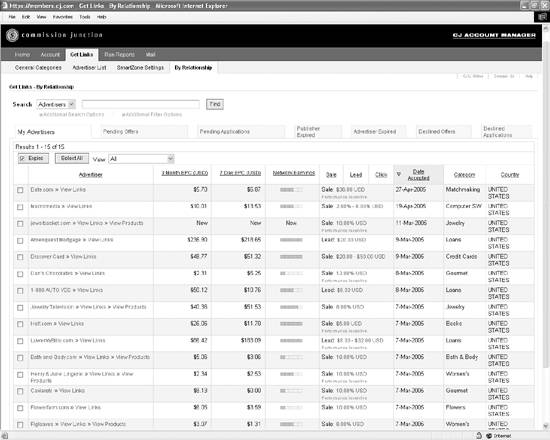 Locate the merchant you want to add to your site. Click View Links. You can now scan all the creatives offered by the merchant. For example, Figure 4-10 shows some of the creatives offered by Half.com to participating affiliates. Figure 4-10. You can view all the creatives supplied by a merchant to decide which ones will work best for your site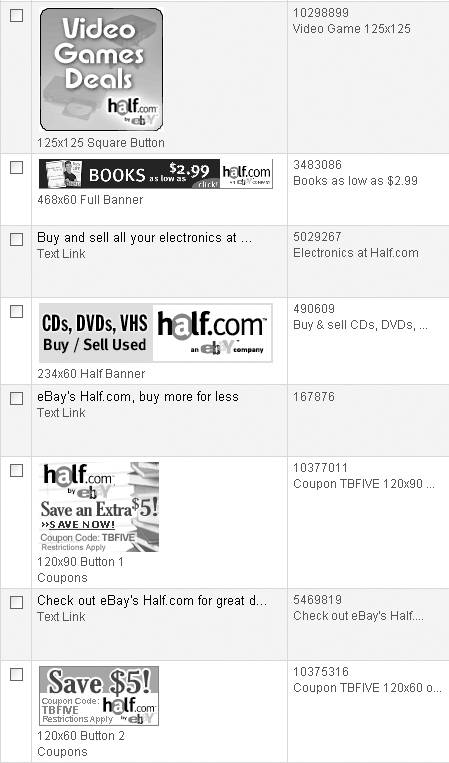 To grab the HTML for a specific creative, either click the creative or check the box next to it and click the Get HTML button at the top of the page. In either case, a Get HTML window, like the one shown in Figure 4-11, will open. Figure 4-11. The Get HTML window lets you copy the HTML for a specific creative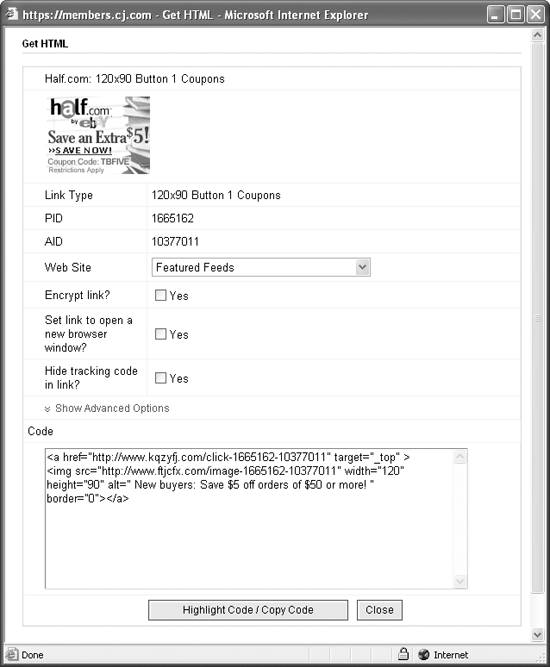
The HTML for the new affiliate link is pretty simple and includes the web publisher's PID (tracking identification) as part of the link: <a href="http://www.kqzyfj.com/click-1665162-10377011" target="_top" > <img src="/books/2/226/1/html/2/http://www.ftjcfx.com/image-1665162-10377011" width="120" height="90" alt=" New buyers: Save $5 off orders of $50 or more! " border="0"></a> If you paste this HTML into the code for your web page, the new creative will now appear on your site (Figure 4-12). Figure 4-12. When you copy the HTML provided by Commission Junction into your page, the merchant's creative appears on your site with your tracking number embedded in the related link
4.3.1.2. LinkShareLinkShare, http://www.linkshare.com, is the oldest major affiliate aggregator, currently representing several hundred merchants ranging from David's Cookies to Overstock.com to Vermont Teddy Bear and beyond. LinkShare provides roughly the same functionality as Commission Junction. The LinkShare home page is shown in Figure 4-13. Within LinkShare, you'll find four tabbed windows in addition to the home page:
Figure 4-13. From the LinkShare home page you can browse merchants, join programs, generate links, and more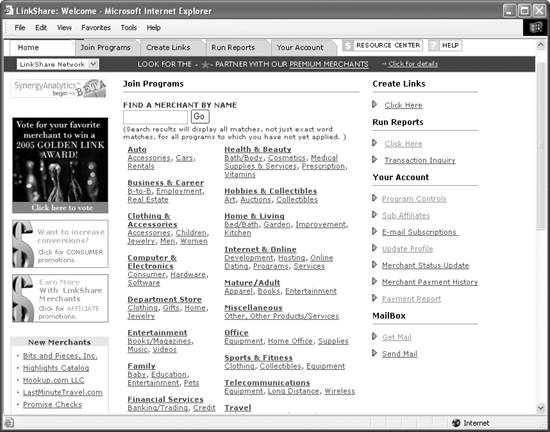
To obtain a creative, click the Create Link tab. A list of the affiliate programs for which you have been approved appears (Figure 4-14). Figure 4-14. You can create links only if you have been approved for a merchant's affiliate program
Click the name of the merchant you'd like to link with, for example, Sierra Trading Post, a discount retailer of sporting goods and clothes. A page that will let you generate creatives specifically for Sierra Trading Post will open. Choose the kind of creative you'd like to create from the Available Link Types box, shown in Figure 4-15. Figure 4-15. Link types range from straight text to search boxes, banners, and more
For example, suppose you want to add a box to your web site that searches the Sierra Trading Post product database. To do this, you'd click the Search Box link. A page showing a number of possible search boxes, such as the one shown in Figure 4-16, will open. Figure 4-16. If you add this search box to your site, visitors can search the Sierra Trading Post product database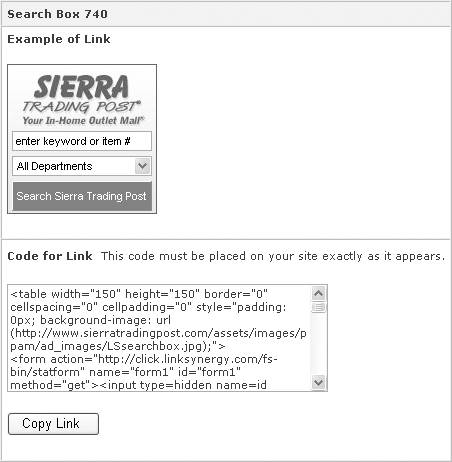 To add the search box to your site, copy the code and paste it into your page. Here's the code that generates the Sierra Trading Post search box: <table width="150" height="150" border="0" cellspacing="0" cellpadding="0" style="padding: 0px; background-image: url (http://www.sierratradingpost.com/assets/images/ppam/ad_images/LSsearchbox.jpg);"> <form action="http://click.linksynergy.com/fs-bin/statform" name="form1" method="get"><input type=hidden name=id value=RQUescWsfWI><input type=hidden name=offerid value=42083><input type=hidden name=bnid value=740><input type=hidden name="subid" value=""> <input type="hidden" name="Ntk" value="All"> <input type="hidden" name="Nty" value="1"> <input type="hidden" name="Ntx" value="mode+matchallany"> <input type="hidden" name="track" value="true"> <input type="hidden" name="DCMP" value="LS05"> <input type="hidden" name="KC" value="LS05"> <tr> <td width="150" height="65"></td> </tr> <tr> <td width="150" align="center" height="25"> <input type="text" name="Ntt" value="enter keyword or item #" maxlength="50" style="font-family: arial,helvetica,sans-serif; font-size: 11px; width: 140px; padding-left: 2px;"> </td> </tr> <tr> <td width="150" align="center" height="25"> <select name="N" style="font-family: arial,helvetica,sans-serif; color: #000000; vertical-align: top; font-size: 11px; width: 105px; height: 18px; width: 140px;"> <option value="0">All Departments</option> <option value="9000310">Outdoor Gear</option> <option value="9000154">Men's Clothing</option> <option value="9000230">Women's Clothing</option> <option value="9000342">Shoes & Boots</option> <option value="9000335">Kids' Corner</option> <option value="9000331">Home Decor</option> </select> </td> </tr> <tr> <td width="150" align="center" height="35"> <input type="submit" value="Search Sierra Trading Post" style="font: 11px arial; color: #ffffff; width: 140px; height: 30px; border: outset 1px; background-color: #447744;"> </td> </form> </tr> </table><IMG width=1 height=1 border=0 src="/books/2/226/1/html/2/http://ad.linksynergy.com/fs- bin/show?id=RQUescWsfWI&bids=42083&type=5">
With this code pasted into your web page, the Sierra Trading Post search box will appear on your site as shown in Figure 4-17. Figure 4-17. Placing a search box on your site is a way to add value for your site visitors If a visitor to your site enters a specific item, for example Men's socks, in the search box and clicks Search Sierra Trading Post, the results page for the item will open (Figure 4-18). This helps to increase the rate of conversion of clicks to sales, because visitors are looking only at items they have some interest in, and therefore increases the likelihood that you will make a commission. Figure 4-18. Providing a way to search a merchant's catalog helps convert click throughs to sales because customers see items they are interested in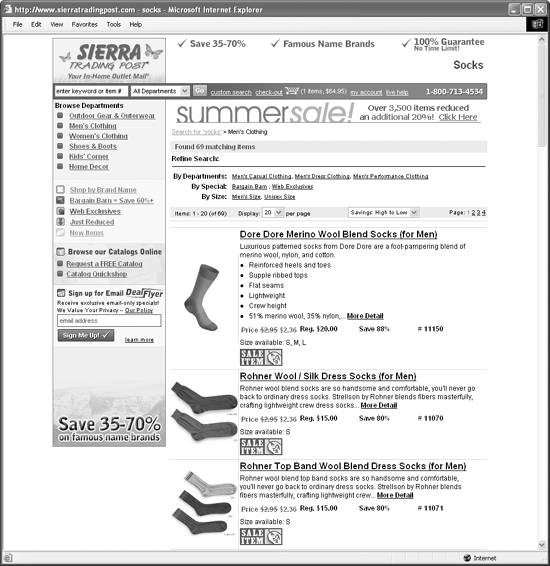 4.3.2. The Amazon.com Associate ProgramIf you belong to just one merchant's affiliate program, Amazon.com is probably the one to join.
Amazon.com makes a great partner for an affiliate (particularly if the affiliate is only going to be associated with one merchant program) for a number of reasons, including:
The application process for becoming an Amazon.com associate can be accessed at https://associates.Amazon.com/gp/flex/associates/apply-login.html. Essentially, Amazon. com approves all applicants who provide a valid email address and the required social security number (or EIN). Amazon.com pays between 4% and 10% sales commissions, with the bulk of the commissions in the 4% to 7% range. In some cases, performance bonuses are given to affiliates who are extraordinary producers. The home page for the Amazon.com Associate program, called Amazon.com Associates Central, is located at http://associates.Amazon.com. Once you've joined the program, you can log in to update your account information, generate reports, and obtain creatives. Click Build Links to specify creatives and obtain the corresponding code. There are five varieties of Amazon.com creatives:
Figure 4-19 shows the launch panel for building this wide selection of creatives at Amazon. For example, suppose you want to add a box on your digital photography site that will display a digital camera that Amazon.com recommends (and let Amazon.com take care of the specifics of which camera is highlighted). To start, click Build Links with Recommended Product Links selected. The Choose Content panel, shown in Figure 4-20, will open. In the Choose Content panel, select a product line and enter keywords or choose a subcategory. For example: if "Camera & Photo" is the primary category, "Digital Cameras" might be a good subcategory (but you could also limit the recommendations to a specific brand by entering "Nikon," "digital," and "camera" as keywords rather than selecting a subcategory. With a content type selected, click Continue. You'll next be asked to select a size for the creative. With a size selected, you can now move to final adjustments (for example, to the colors used in the text and background of the creative) and copy the HTML, using the window shown in Figure 4-21. Figure 4-19. The launch panel for building creatives at Amazon.com shows examples of what the finished link will look like Figure 4-20. Use the Choose Content panel to specify what kinds of products Amazon.com will recommend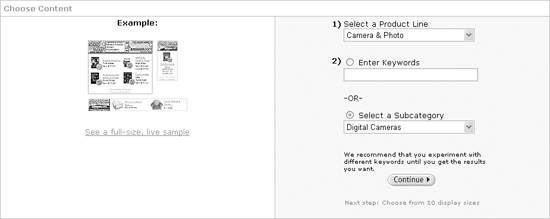 Here's the HTML produced for this creative: <iframe src="/books/2/226/1/html/2/http://rcmAmazon.com/e/cm?t=XXXXXXXXX&o=1&p=8&l=bn1& mode=photo&browse=281052&fc1=&=1&lc1=<1=&f=ifr&bg1=&f=ifr" marginwidth="0" marginheight="0" width="120" height="240" border="0" frameborder="0" style="border:none;" scrolling="no"> </iframe> Figure 4-21. By clicking the links shown, you can customize the creative or just copy the HTML for use on your site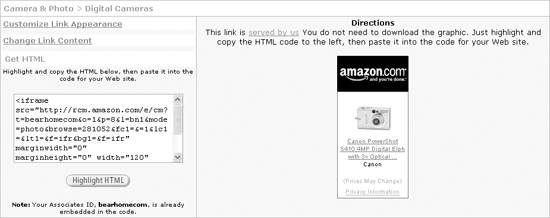
When you copy this HTML into an include used by your digital photography site, the creative appears, as you can see in Figure 4-22. Figure 4-22. Once the HTML has been copied to your web site, the Amazon.com creative appears on your pages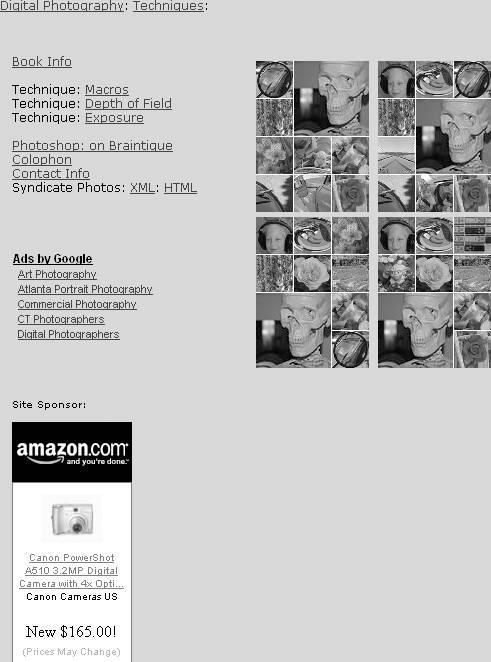
|
EAN: 2147483647
Pages: 145

 Web site Settings, you can add a new web site for deployment with the Commission Junction affiliate programs (Figure 4-5).
Web site Settings, you can add a new web site for deployment with the Commission Junction affiliate programs (Figure 4-5).